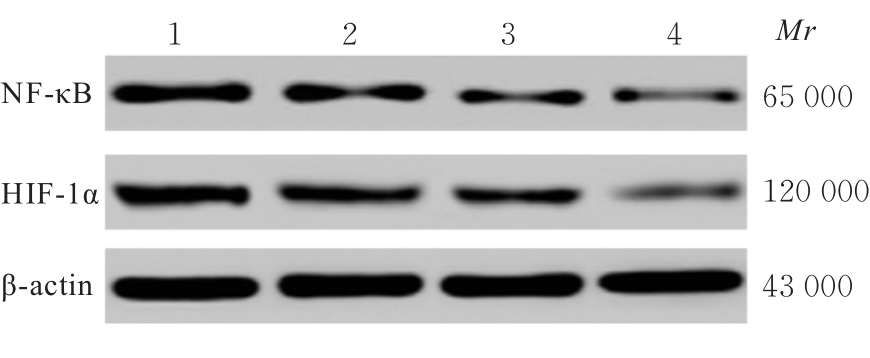| [1] |
Shuang CHEN,Hong LI.
Effect of silencing FOXK1 gene on proliferation, migration, and invasion of gastric cancer HGC-27 cells
[J]. Journal of Jilin University(Medicine Edition), 2024, 50(2): 371-378.
|
| [2] |
Chang GAO,Yan LIU,Haoxiang YANG,Cuicui ZHANG.
Effect of long non-coding RNA MALAT1 on angiogenesis of human brain microvascular endothelial cells induced by oxygen-glucose deprivation/reoxygenation hypoxic
[J]. Journal of Jilin University(Medicine Edition), 2023, 49(4): 832-839.
|
| [3] |
Haitao LI, Qin LI, Fei CAI, Guofu HU, Yunfei TENG.
Effect of apigenin on polarization and inflammation of mouse RAW264.7 macrophages and its mechanism
[J]. Journal of Jilin University(Medicine Edition), 2023, 49(3): 549-556.
|
| [4] |
Bo HUANG,Jie DING,Hongrong GUO,Hongjuan WANG,Jianqun XU,Quan ZHENG.
Effects of HIF-1α/ROS on apoptosis and invasion of lung cancer A549 cells under hypoxia and its mechanism
[J]. Journal of Jilin University(Medicine Edition), 2023, 49(3): 682-690.
|
| [5] |
Yan YU,Chengcheng YU,Yakun HAN.
Analysis on phenotypes of plasma cells of gingiva and expression characteristics of RANKL in patients with periodontitis complicated with rheumatoid arthritis
[J]. Journal of Jilin University(Medicine Edition), 2023, 49(3): 757-764.
|
| [6] |
Xinghong GAO,Hongmei TANG,Yuejiao LI,Xiaoyun WANG,Xing WANG,Xiefang YUAN,Min WU.
Attenuating effect of translocator protein ligand XBD173 on pulmonary inflammatory response induced by cigarette smoke extraction in mice and its mechanism
[J]. Journal of Jilin University(Medicine Edition), 2023, 49(2): 272-279.
|
| [7] |
Xiaojuan ZHU,Haitao DAI,Yan LI,Lingxin CUI,Ya WANG,Jiang XU,Nan WU.
Improvement effect of grape seed proanthocyanidin extract on periodontal inflammation in diabetic periodontitis rats and its influence on expression levels of TLR4 and NF-κB in periodontal tissue
[J]. Journal of Jilin University(Medicine Edition), 2023, 49(1): 31-38.
|
| [8] |
Kexin CHEN,Donghao QU,Xiaolong LIU,Bo CHEN,Shuyan ZHANG.
Effect of CD47 knockout on angiogenesis after traumatic brain injury in mice and its molecular mechanism
[J]. Journal of Jilin University(Medicine Edition), 2022, 48(4): 839-846.
|
| [9] |
Junjie HOU,Xuguang MI,Xiaonan LI,Xiaonan LI,Ying YANG,Xianzhuo JIANG,Ying ZHOU,Zhiqiang NI,Ningyi JIN,Yanqiu FANG.
Bronchopleural fistula complicated in treatment process of non-small cell lung cancer by bevacizumab combined with paclitaxel: A case report and literature review
[J]. Journal of Jilin University(Medicine Edition), 2022, 48(2): 513-517.
|
| [10] |
Yang ZHENG,Jiahui WANG,Yue PENG,Xianling YUAN,Lei WANG,Tiejian ZHAO.
Influence of curcumol in structure of liver sinusoidal endothelial cells of mice and its inhibitiory effect on intrahepatic angiogenesis
[J]. Journal of Jilin University(Medicine Edition), 2021, 47(5): 1124-1130.
|
| [11] |
Haojie WU,Minghui ZHANG,Chengzhi HONG.
Improvement effect of diosgenin on symptoms of synovitis rats and its reglatory effect on TLR2-NF-κB signaling pathway and mechanism
[J]. Journal of Jilin University(Medicine Edition), 2021, 47(4): 943-950.
|
| [12] |
Xiulan YE, Ming LI, Zhaojian WANG, Haiyan ZHAO, Jianning MA, Jing LIU, Yi ZHENG, Shunqing LI, Yu ZHANG.
Effects of Cornus officinalis polysaccharide on behavior and multidrug resistance gene 1b and major vault protein expressions in hippocampus tissue of refractory epilepsy young rats
[J]. Journal of Jilin University(Medicine Edition), 2021, 47(3): 644-651.
|
| [13] |
Bo WANG,Yan YANG,Rui FEI,Niancai JING,Zhaodong LI,Yi LU,Hongyu XIAO,Yue ZHANG.
Inhibitory effect of Shuganhuazheng Formula on growth of triple negative breast cancer of subcutaneous transplantation in mice
[J]. Journal of Jilin University(Medicine Edition), 2021, 47(2): 299-306.
|
| [14] |
Guo HUANG,Youquan WANG,Juan CHEN.
Reverse effect of miR-138-5p targeted inhibition of HIF-1α expression on cisplatin resistance of breast cancer MCF-7 cells and its mechanism
[J]. Journal of Jilin University(Medicine Edition), 2021, 47(2): 360-368.
|
| [15] |
Lijun YAN,Shengquan TONG,Jing LIU,Dongmei GAO,Nanfang CHEN,Jie HU.
Therapeutic effect of total glucosides of paeony in model rats with rheumatoid arthritis by mediating TLR4/NF-κB signaling pathway and its mechanisim
[J]. Journal of Jilin University(Medicine Edition), 2021, 47(2): 390-396.
|










